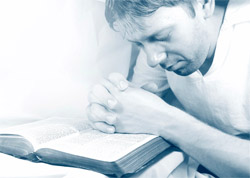Hovering Over Disaster
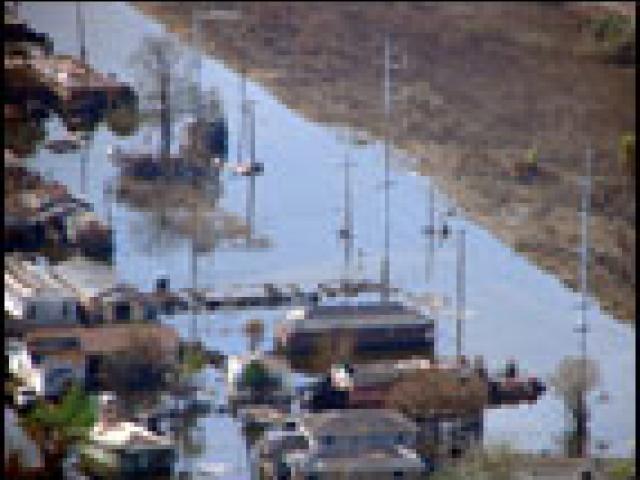
NEW ORLEANS, Louisiana -- New Orleans; the city of jazz, of Mardi Gras, of the French Quarter -- all those things I had seen on television throughout my life, but had never had the chance to see in person. Now I would travel to New Orleans, but not on the ground -- I would hover over the disaster area in a four-person helicopter.
I traveled with an experienced videographer from The 700 Club who wanted the door removed so that there would be no hindrance to his shots. Being only my second time in a helicopter, I was happy to shoot through the window, making sure my seat belt was securely fastened.
The helicopter pilots were both volunteers for Operation Blessing who had made themselves available to The 700 Club. "We only have enough fuel for a 35 minute flight," one of the pilots informed me as we climbed aboard. 'Low on fuel and we haven't even left yet?' I thought, 'not exactly the way I'd like to begin the journey.'
We climbed aboard and loaded our gear, making sure everything was secured since there would be no door on the left side.
"Clear!" the pilot hollered as he started the engines. "Clear!" he called out again after a few seconds and slowly the copter lifted from the ground. Only a few feet above the makeshift airfield until it began moving forward and rising rapidly. Within seconds we were above the trees, moving swiftly toward Lake Pontchartrain.
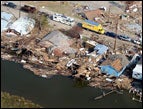 As soon as we were over the tree line we began to see the damage to homes lining the canals that feed into the lake. In many places, piles of debris littered the yards and clogged the waterways. Large pleasure boats sat awkwardly on their sides in the yards or on the streets, obviously hurled there by the force of the water. In only a few short minutes we were out over the open water of this vast lake, speeding above Interstate 10 below (later I was told that the pilot did this so that if he ran out of fuel he'd have somewhere to land).
As soon as we were over the tree line we began to see the damage to homes lining the canals that feed into the lake. In many places, piles of debris littered the yards and clogged the waterways. Large pleasure boats sat awkwardly on their sides in the yards or on the streets, obviously hurled there by the force of the water. In only a few short minutes we were out over the open water of this vast lake, speeding above Interstate 10 below (later I was told that the pilot did this so that if he ran out of fuel he'd have somewhere to land).
My colleague from The 700 Club had flown over the disaster zone several times the week before. I was not on the communication headphones, and I couldn't hear him under the whir of the chopper 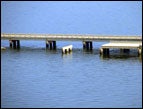 blades. He signaled to me to look down at I-10 rushing past us below. As I peered out past him through the opened door I saw what the news had reported -- several spans of the bridge were missing, washed away by the storm whose eye passed more than 40 miles to the east of the city. And yet even that far from the storm's greatest power it still was able to hurl huge sections of this concrete bridge into the lake.
blades. He signaled to me to look down at I-10 rushing past us below. As I peered out past him through the opened door I saw what the news had reported -- several spans of the bridge were missing, washed away by the storm whose eye passed more than 40 miles to the east of the city. And yet even that far from the storm's greatest power it still was able to hurl huge sections of this concrete bridge into the lake.
We entered the northeastern section of the city and immediately observed flooded neighborhoods. This is a low-lying part of New Orleans, filled with bogs and swamps. I was surprised that anyone would want to build a home in such a swampy area, but there they were below us, deluged with water -- many of the roofs had their shingles removed by the wind.
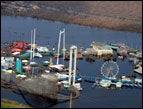 A short distance from these submerged neighborhoods was a flooded amusement park. The Ferris wheel and roller coaster rose from the silvery-gray water that covered the ground.
A short distance from these submerged neighborhoods was a flooded amusement park. The Ferris wheel and roller coaster rose from the silvery-gray water that covered the ground.
As we moved south the scene began to change beneath us. The closer we got to the city the less flooding we observed. This is the industrial part of town, dotted with warehouses, shipping facilities, and fuel tanks. As we emerged over the Mississippi River, we noticed that there was activity along the waterfront. Though it was not bustling, there were a few ocean liners cruising down the river toward the Gulf of Mexico. The continuation of commerce on the river was a welcome sight.
Docked at the edge of the river, just across from downtown, was one of the Carnival Cruise ships that were sent to house some of the evacuees. Sometimes ironic images convey so much more than words can, and that's how I felt as we passed this 'fun ship' -- an ocean vessel designed for no other purpose but to provide entertainment to her passengers. And yet here it was, serving as a host for families displaced by the storm. 'Quite a contrast to its original purpose,' I thought.
Crossing over the eastern side of the Mississippi, we could now clearly see the skyscrapers of downtown -- and the damaged roof of the Superdome in the distance. Our flight path led us away from the center of the city -- I learned later that air traffic strictly limited over the downtown area. The further we flew toward the south the better the conditions appeared to be below us.
We passed over the shipyards and warehouses lining the zig-zagging river below and saw much more activity in this section of town. Suddenly we turned and began heading north again. We moved directly toward the downtown area. I was now able to have a clear view of the damage done to the roof of the Superdome. I took several photos of the downtown, the Superdome, and the now-closed Interstate 10.
As we skirted the city again on the east side, flying above the river, I saw another giant white Carnival cruise ship even closer to the downtown. Smoke was rising from the great whale tale flume that rose from the back of the ship, hints of activity inside the grand vessel.
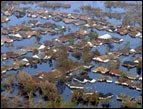 We sped north, once again passing the flooded amusement park and neighborhoods, skirting across the lake above the damaged I-10. Arriving back in Slidell, Louisiana, on the north side of the lake, we came in for a landing over a small airfield surrounded by thick evergreen trees. The National Guard had an encampment nearby and one of their large helicopters sat at the end of one of the runways surrounded by troops preparing for a mission.
We sped north, once again passing the flooded amusement park and neighborhoods, skirting across the lake above the damaged I-10. Arriving back in Slidell, Louisiana, on the north side of the lake, we came in for a landing over a small airfield surrounded by thick evergreen trees. The National Guard had an encampment nearby and one of their large helicopters sat at the end of one of the runways surrounded by troops preparing for a mission.
After we landed I learned that we were just about out of gas and would have to refuel before we returned to the city. The large tanker drove up next to the helicopter and began filling the bird as the pilots walked over to a nearby hanger to confirm directions to our destination.
Within a few short minutes we were airborne again and following the 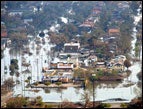 same route over the I-10 bridge. This time we stayed above the train bridge that runs parallel to the highway and entered the city directly from the north, flying above the levees on the south side of Lake Pontchartrain. Soon we were above the hardest hit part of the city. Below us we could now see the vast expanse of flooded neighborhoods and damaged buildings.
same route over the I-10 bridge. This time we stayed above the train bridge that runs parallel to the highway and entered the city directly from the north, flying above the levees on the south side of Lake Pontchartrain. Soon we were above the hardest hit part of the city. Below us we could now see the vast expanse of flooded neighborhoods and damaged buildings.
Block after block, houses, apartment buildings, and businesses sat in several feet of putrid water -- the toxic brew a mix of sewage, oil, chemicals, and water from the lake, far too dangerous for anyone to go 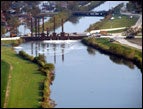 near without protective clothing and gear. Though I didn't smell it, another CBN camera man said that when he flew over the flooded part of this city a few days earlier, he could smell the sewage from the helicopter.
near without protective clothing and gear. Though I didn't smell it, another CBN camera man said that when he flew over the flooded part of this city a few days earlier, he could smell the sewage from the helicopter.
Every few blocks a canal ran through the city separating one flooded section from another. We got close enough to see one of the working pumping stations, slowly pulling the poisoned water from the city and pumping it back into the lake.
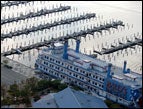 Along the waterfront we passed over a severely damaged floating casino, its' front end sticking up out of the water, its' side flanked by damaged yachts and sailboats that had been flung from the water and deposited on the ground. Not far beyond the damaged casino was the airport -- damaged and overturned aircraft dotted the field, a car sat mostly submerged in the nearby canal, and metal siding from the hangars laid twisted around telephone poles and stop signs. There was no activity from the field below, only mud-covered runways.
Along the waterfront we passed over a severely damaged floating casino, its' front end sticking up out of the water, its' side flanked by damaged yachts and sailboats that had been flung from the water and deposited on the ground. Not far beyond the damaged casino was the airport -- damaged and overturned aircraft dotted the field, a car sat mostly submerged in the nearby canal, and metal siding from the hangars laid twisted around telephone poles and stop signs. There was no activity from the field below, only mud-covered runways.
After a short distance we crossed over the Lake Pontchartrain 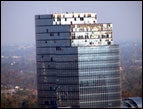 Causeway and turned south. To the left we flew past the Wyndham Hotel, dozens of its windows were blown out, giving the mirrored building a checkerboard appearance.
Causeway and turned south. To the left we flew past the Wyndham Hotel, dozens of its windows were blown out, giving the mirrored building a checkerboard appearance.
We turned west and flew through the less damaged parts of the suburbs. Though there was no flooding in this part of town, there was plenty of wind damage. In some places, large sections of buildings were blown off, exposing the interior. Up and down the main streets large plastic restaurant signs had been blown out or bent over by the force of the winds. Gas station canopies lay in many places like mangled balls of aluminum foil.
As we approached the Operation Blessing distribution center on the west side of town we circled the training facility of the New Orleans Saints. Helicopters of various sizes and shapes sat on the practice field in front of the large warehouse-type facility. Across the front of the giant building the 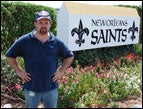 NFL logo and the Saints' logo were painted in bright colors. In the adjoining parking lot, dozens of RVs were parked in rows and beyond them were even more rescue and military vehicles of various types and colors. The pilot set the helicopter down near the 50 yard line of the Saints' practice field and we hopped out, keeping our heads low as the rotors spun above our heads. I still couldn't hear a thing, but I shook the hand of the pilot and yelled thank you into his ear.
NFL logo and the Saints' logo were painted in bright colors. In the adjoining parking lot, dozens of RVs were parked in rows and beyond them were even more rescue and military vehicles of various types and colors. The pilot set the helicopter down near the 50 yard line of the Saints' practice field and we hopped out, keeping our heads low as the rotors spun above our heads. I still couldn't hear a thing, but I shook the hand of the pilot and yelled thank you into his ear.
We grabbed our gear and walked away from the copter, our heads still low, just in case. Behind us the small, gray helicopter rose into the sky and then turned to make its way back to Slidell. When the bird was far enough away that we could hear each other again, my co-worker explained why our trip had once again been cut short. "The president is flying into New Orleans and they've ordered all aircraft out of the sky. The pilots had to drop us off and get out of town quickly or they would have been stuck on the ground."
We toted our gear over to the church next door where volunteers were unloading a shipment of supplies from Operation Blessing. That night I sat in one of our RVs and watched the president, only miles from my location, addressing a national television audience and declaring that New Orleans would be rebuilt.
The next day, as we drove out of town, we had a hard time finding an on-ramp to the highway. We were blocked by broken water mains, damaged on-ramps, flooded streets, and National Guard blockades. In an attempt to find an open highway, we drove down into one of the flood zones. By now the water had receded somewhat, but the streets were clogged with mud, garbage, and debris from the storm. The smell of sewer was rancid and we were far from the worst part of the city. National Guard troops stood at the entrance to the neighborhood and signaled for us to turn around.
After receiving directions from one of the locals, we made our way back to the western suburbs, but still could not find an open on-ramp to the highway -- a frustration made even more perplexing by the cars that were speeding by on the highway itself. Heading west we passed from one closed on-ramp to another, wondering how far we would have to go to 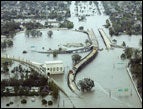 find a working entrance. Stopping to once again ask for directions, we were overtaken by the putrid smell of sewer and chemicals that hung heavily in the air -- and this was now several miles from any flooding. The toxic soup was being washed into this neighborhood through the series of canals that connected to the flood zone.
find a working entrance. Stopping to once again ask for directions, we were overtaken by the putrid smell of sewer and chemicals that hung heavily in the air -- and this was now several miles from any flooding. The toxic soup was being washed into this neighborhood through the series of canals that connected to the flood zone.
Finally, after a 45-minute search, we found an on-ramp to I-10 and worked our way toward the Lake Pontchartrain Causeway, the last exit that was still open. As we approached Causeway Boulevard, a line of military vehicles, rescue equipment, police cars, ambulances, and relief worker RVs sat in the left lane, awaiting permission to enter the city. National Guard troops and Louisiana State Police checked each vehicle before allowing them to continue on I-10 into the downtown. We skirted the traffic and took the off-ramp heading toward the causeway.
On the other side of Lake Pontchartrain we linked up with Interstate 12, heading east and then north out of Louisiana. The other side of the highway was clogged with cars, rescue vehicles, RVs, utility trucks, and semi-tractor-trailers all working their way slowly toward the damaged city. The western suburbs were opening for people to return to their homes, and there was a rumor that the New Orleans mayor was going to start opening the lesser damaged sections of the city.
As I gazed over toward the hundreds of people heading back to New Orleans I lifted up a prayer. "Lord, help these people to regain what has been lost. And for those who can't rebuild, help them to find a new place to call home."


